Research on Multi-Objective Optimization of High-Speed Solenoid Valve Drive Strategies under the Synergistic Effect of Dynamic Response and Energy Loss
Abstract
:1. Introduction
2. Establishment and Verification of HSV Simulation Model
2.1. Mathematical Model
2.2. HSV Finite Element Model Coupled with Current Feedback Model
2.3. Verification of HSV Simulation Model
3. Influence of Driving Strategies on HSV Working Characteristics
3.1. Dynamic Response Characteristics
3.2. Energy Consumption Characteristics
4. Optimization of HSV Driving Strategy Based on BPNN-NSGA-II
4.1. Prediction Model of BPNN
4.1.1. Sample Data
4.1.2. Model Training
4.1.3. Model Verification
4.2. Multi-Objective Optimization Model of NSGA-II
4.3. Optimization Results
5. Conclusions
Author Contributions
Funding
Data Availability Statement
Conflicts of Interest
Abbreviations and Symbols
| Abbreviations | |||
| HSV | high-speed solenoid valve | ||
| BPNN | back propagation neural network | ||
| NSGA-II | Non-dominated Sorting Genetic Algorithm II | ||
| FEM | finite element model | ||
| Symbols | |||
| U | coil driving voltage, V | Bm | magnetic induction intensity, T |
| R | coil resistance, Ω | d | the wall thickness of the iron core, m |
| I | current, A | ρ | resistivity, Ω·m |
| N | turns number of the coil, - | EJou. | Joule energy, mJ |
| Φ | magnetic flux, Wb | Eela. | elastic energy, mJ |
| t | time, s | Edam. | damping energy, mJ |
| Fmag | electromagnetic force, N | Ekin. | kinetic energy, mJ |
| μ | magnetic conductivity of air, H/m | Vd | moving speed of armature, m/s |
| S | suction area, m2 | Vpeak | Peak voltage, V |
| λ | damping coefficient, N/(m/s) | Ipeak | Peak current, A |
| k | spring stiffness, N/m | Tpeak | Peak current loading time, s |
| x | armature displacement, m | Ihold I | First-order holding current, A |
| F0 | spring preload force, N | Thold I | First-order holding current loading time, s |
| m | armature mass, kg | Ihold II | Second-order holding current, A |
| Eele. | HSV drive energy, W | Tlift | armature motion time, s |
| Eedd. | eddy energy, W | Topen | solenoid valve opening response time, s |
| Cedd. | eddy current coefficient, - | τ | effective time ratio, - |
| f | frequency of magnetic field, Hz | Tforce | overcoming resistance time, s |
References
- Duan, X.; Lai, M.C.; Jansons, M.; Guo, G.; Liu, J. A review of controlling strategies of the ignition timing and combustion phase in homogeneous charge compression ignition (HCCI) engine. Fuel 2021, 285, 119142. [Google Scholar] [CrossRef]
- Shi, Z.; Lee, C.-F.; Wu, H.; Li, H.; Wu, Y.; Zhang, L.; Bo, Y.; Liu, F. Effect of injection pressure on the impinging spray and ignition characteristics of the heavy-duty diesel engine under low-temperature conditions. Appl. Energy 2020, 262, 114552. [Google Scholar] [CrossRef]
- Shi, Z.; Wu, H.; Li, H.; Zhang, L.; Li, X.; Lee, C.-F. Effect of injection pressure and fuel mass on wall-impinging ignition and combustion characteristics of heavy-duty diesel engine at low temperatures. Fuel 2021, 299, 120904. [Google Scholar] [CrossRef]
- Ishii, E.; Yoshimura, K.; Yasukawa, Y.; Ehara, H. Effects of Opening and Closing Fuel-Injector Valve on Air/Fuel Mixture. J. Eng. Gas Turbines Power 2017, 139, 092804. [Google Scholar] [CrossRef]
- Wang, Q.; Yang, F.; Yang, Q.; Chen, J.; Guan, H. Experimental analysis of new high-speed powerful digital solenoid valves. Energy Convers. Manag. 2011, 52, 2309–2313. [Google Scholar] [CrossRef]
- Tao, G.; Chen, H.Y.; YY, J.; He, Z.B. Optimal design of the magnetic field of a high-speed response solenoid valve. J. Mater. Process. Technol. 2002, 129, 555–558. [Google Scholar] [CrossRef]
- Stosiak, M.; Karpenko, M.; Prentkovskis, O.; Deptuła, A.; Skačkauskas, P. Research of vibrations effect on hydraulic valves in military vehicles. Def. Technol. 2023, 30, 111–125. [Google Scholar] [CrossRef]
- Liu, P.; Fan, L.; Zhou, W.; Ma, X.; Song, E. Dynamic performances analysis and optimization of novel high-speed electromagnetic actuator for electronic fuel injection system of diesel engine. J. Mech. Sci. Technol. 2017, 31, 4019–4028. [Google Scholar] [CrossRef]
- Ebrahimi, N.; Schimpf, P.; Jafari, A. Design optimization of a solenoid-based electromagnetic soft actuator with permanent magnet core. Sens. Actuators A Phys. 2018, 284, 276–285. [Google Scholar] [CrossRef]
- Zhao, J.; Wang, M.; Wang, Z.; Grekhov, L.; Qiu, T.; Ma, X. Different boost voltage effects on the dynamic response and energy losses of high-speed solenoid valves. Appl. Therm. Eng. 2017, 123, 1494–1503. [Google Scholar] [CrossRef]
- Zhao, J.; Yue, P.; Grekhov, L.; Ma, X. Hold current effects on the power losses of high-speed solenoid valve for common-rail injector. Appl. Therm. Eng. 2018, 128, 1579–1587. [Google Scholar] [CrossRef]
- Breidi, F.; Helmus, T.; Lumkes, J. The impact of peak-and-hold and reverse current solenoid driving strategies on the dynamic performance of commercial cartridge valves in a digital pump/motor. Int. J. Fluid Power 2016, 17, 37–47. [Google Scholar] [CrossRef]
- Lu, H.; Deng, J.; Hu, Z.; Wu, Z.; Li, L. Impact of Control Methods on Dynamic Characteristic of High Speed Solenoid Injectors. SAE Int. J. Engines 2014, 7, 1155–1164. [Google Scholar] [CrossRef]
- Li, T.; Zhang, Y.; Wang, D.; Xiong, Q. Optimization Design of High-speed Solenoid Based on Multi-objective Simulated Annealing Method. Veh. Engine 2010, 4, 6–10. (In Chinese) [Google Scholar]
- Liu, P.; Fan, L.; Xu, D.; Ma, X.; Song, E. Multi-Objective Optimization of High-Speed Solenoid Valve Based on Response Surface and Genetic Algorithm; SAE Technical Paper 2015, 2015-01-1350; Harbin Engineering University: Harbin, China, 2015. [Google Scholar]
- Li, T.; Zhang, Y.; Liang, Y.; Yang, Y.; Jiao, J. Multiobjective optimization research on the response time of a pneumatic pilot-operated high speed on/off valve. Int. J. Appl. Electromagn. Mech. 2021, 65, 109–127. [Google Scholar] [CrossRef]
- Fan, L.; Zhou, W.; Liu, P.; Zhao, J.; Grekhov, L. Multiobjective optimization of dynamic response of high speed solenoid valve. J. Harbin Eng. Univ. 2018, 39, 53–59. (In Chinese) [Google Scholar]
- Shen, D.; Hao, Z.; Zhao, G.; Li, X. Multi-objective optimization design of solenoid valve based on BP neural network. J. Xi’an Polytech. Univ. 2023, 37, 1–8. (In Chinese) [Google Scholar]
- Li, M.; Zhang, Y. Influence of eddy current on transient characteristics of common rail injector solenoid valve. J. Beijing Inst. Technol. 2015, 24, 26–34. [Google Scholar]
- Xie, N.; Zhang, Z.; Yin, C. Power losses and thermodynamic analysis of the solenoid fuel injector. Int. J. Appl. Electromagn. Mech. 2017, 54, 405–419. [Google Scholar] [CrossRef]
- Cheng, Q.; Xu, M.; Zhang, Z.; Xie, N. FEM simulation and performance analysis of a novel heated tip SIDI injector. Int. J. Heat Fluid Flow 2016, 59, 87–99. [Google Scholar] [CrossRef]
- Zhao, J.; Zirka, S.E.; Moroz, Y.I. Duality-Derived Models of High-Speed Electromagnetic Valves. IEEE Trans. Ind. Electron. 2021, 68, 9876. [Google Scholar] [CrossRef]
- Eriksson, L.; Johansson, E.; Kettaneh-Wold, N.; Wikström, C.; Wold, S. Design of experiments. In Principles and Applications, 3rd ed.; Umetrics Academy: Umea, Sweden, 2008. [Google Scholar]
- Myers, R.H.; Montgomery, D.C.; Anderson-Cook, C.M. Response Surface Methodology: Process and Product Optimization Using Designed Experiments, 3rd ed.; John Wiley and Sons: Hoboken, NJ, USA, 2009. [Google Scholar]
- Kuram, E.; Ozcelik, B.; Bayramoglu, M.; Demirbas, E.; Simsek, B.T. Optimization of cutting fluids and cutting parameters during end milling by using D-optimal design of experiments. J. Clean. Prod. 2013, 42, 159–166. [Google Scholar] [CrossRef]
- Lecun, Y.; Bengio, Y.; Hinton, G. Deep Learning. Nature 2015, 521, 436–444. [Google Scholar] [CrossRef] [PubMed]
- Wang, G.; Awad, O.I.; Liu, S.; Shuai, S.; Wang, Z. NOx emissions prediction based on mutual information and back propagation neural network using correlation quantitative analysis. Energy 2020, 198, 117286. [Google Scholar] [CrossRef]
- Ma, X.; Liu, D. Comparative Study of Hybrid Models Based on a Series of Optimization Algorithms and Their Application in Energy System Forecasting. Energies 2016, 9, 640. [Google Scholar] [CrossRef]
- Dong, Y.; Ma, X.; Ma, C.; Wang, J. Research and Application of a Hybrid Forecasting Model Based on Data Decomposition for Electrical Load Forecasting. Energies 2016, 9, 1050. [Google Scholar] [CrossRef]
- Yu, Z.; Wei, S.; Wu, C.; Wu, L.; Sun, L.; Zhang, Z. Development and verification of RP-3 aviation kerosene surrogate fuel models using a genetic algorithm. Fuel 2022, 312, 122853. [Google Scholar] [CrossRef]
- Marler, R.T.; Arora, J.S. Survey of multi-objective optimization methods for engineering. Struct. Multidiscip. Optim. 2004, 26, 369–395. [Google Scholar] [CrossRef]
- Srinivas, N.; Deb, K. Multi-objective function optimization using nondominated sorting genetic algorithms. Evol. Comput. 1995, 2, 221–248. [Google Scholar] [CrossRef]
- Deb, K.; Agrawal, S.; Pratap, A.; Meyarivan, T. A fast elitist nondominated sorting genetic algorithm for multi-objective optimization: NSGA-II. In Proceedings of the International Conference on Parallel Problem Solving from Nature, Paris, France, 18–20 September 2000; pp. 849–858. [Google Scholar]
- Gu, Y.; Fan, L.; Lan, Q.; Wei, Y.; Zhou, J.; Du, K. Multi-objective optimization of fuel injection performance of a common rail injector. Int. J. Engine Res. 2023, 24, 3282–3296. [Google Scholar] [CrossRef]

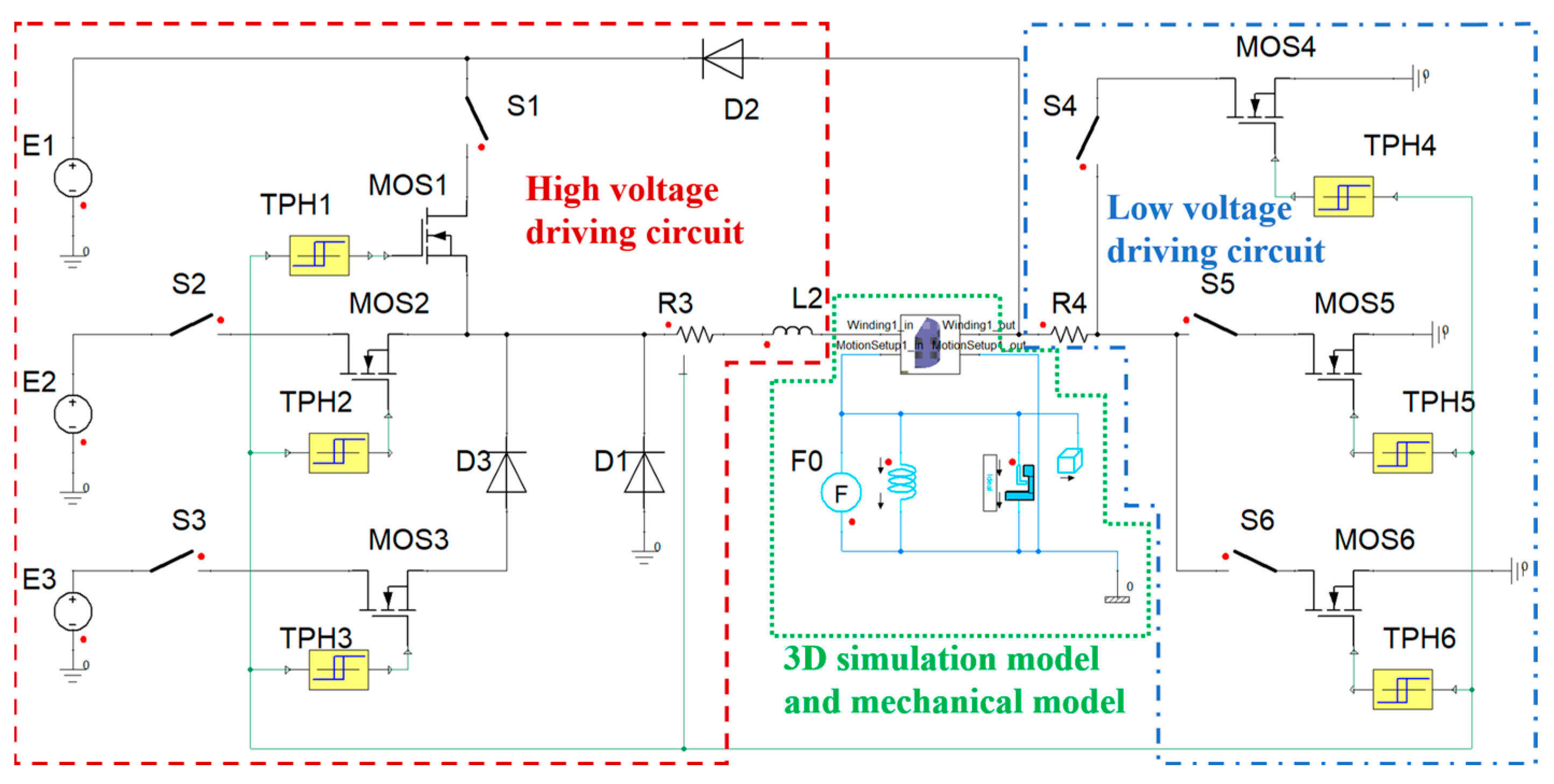

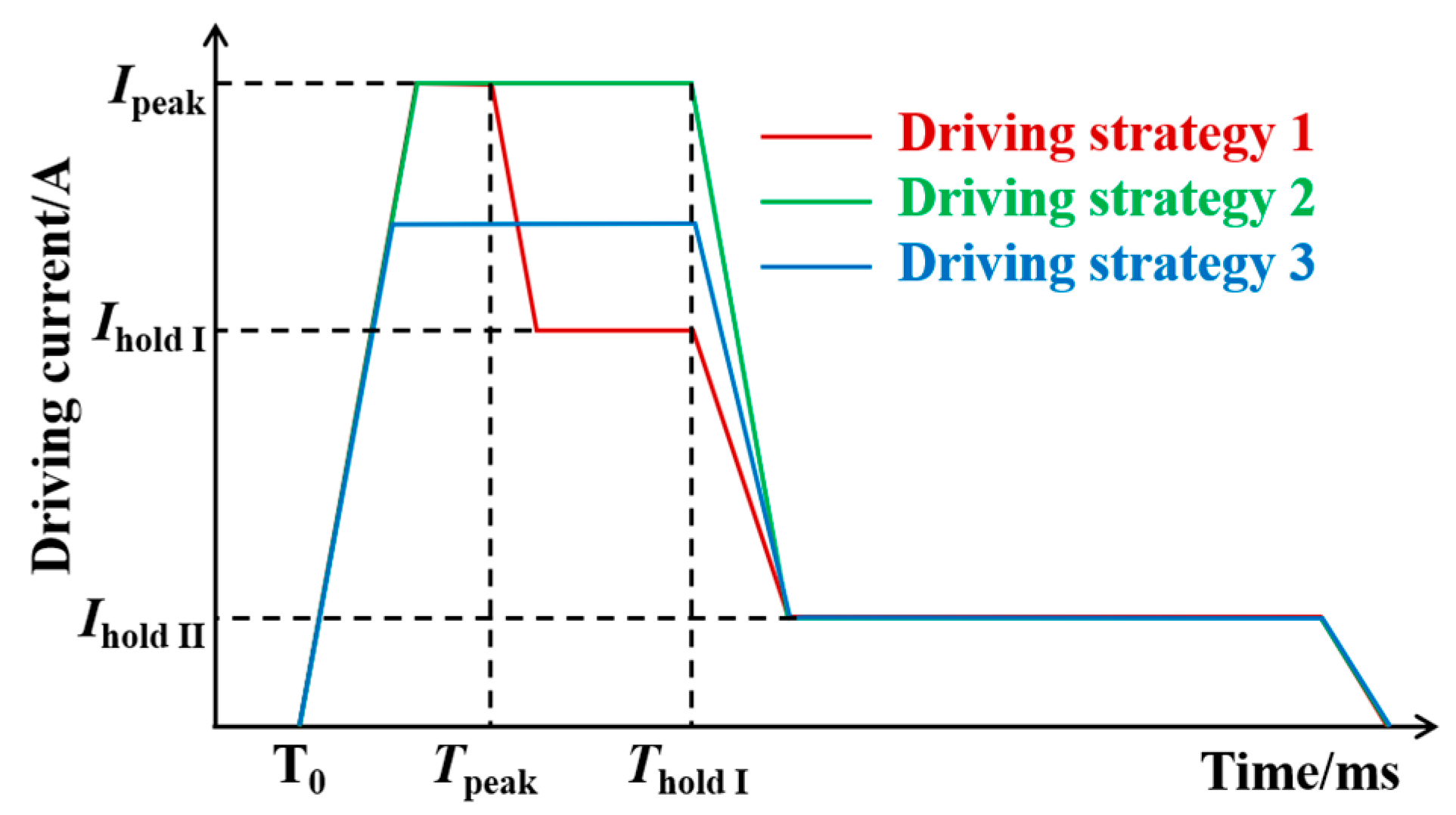

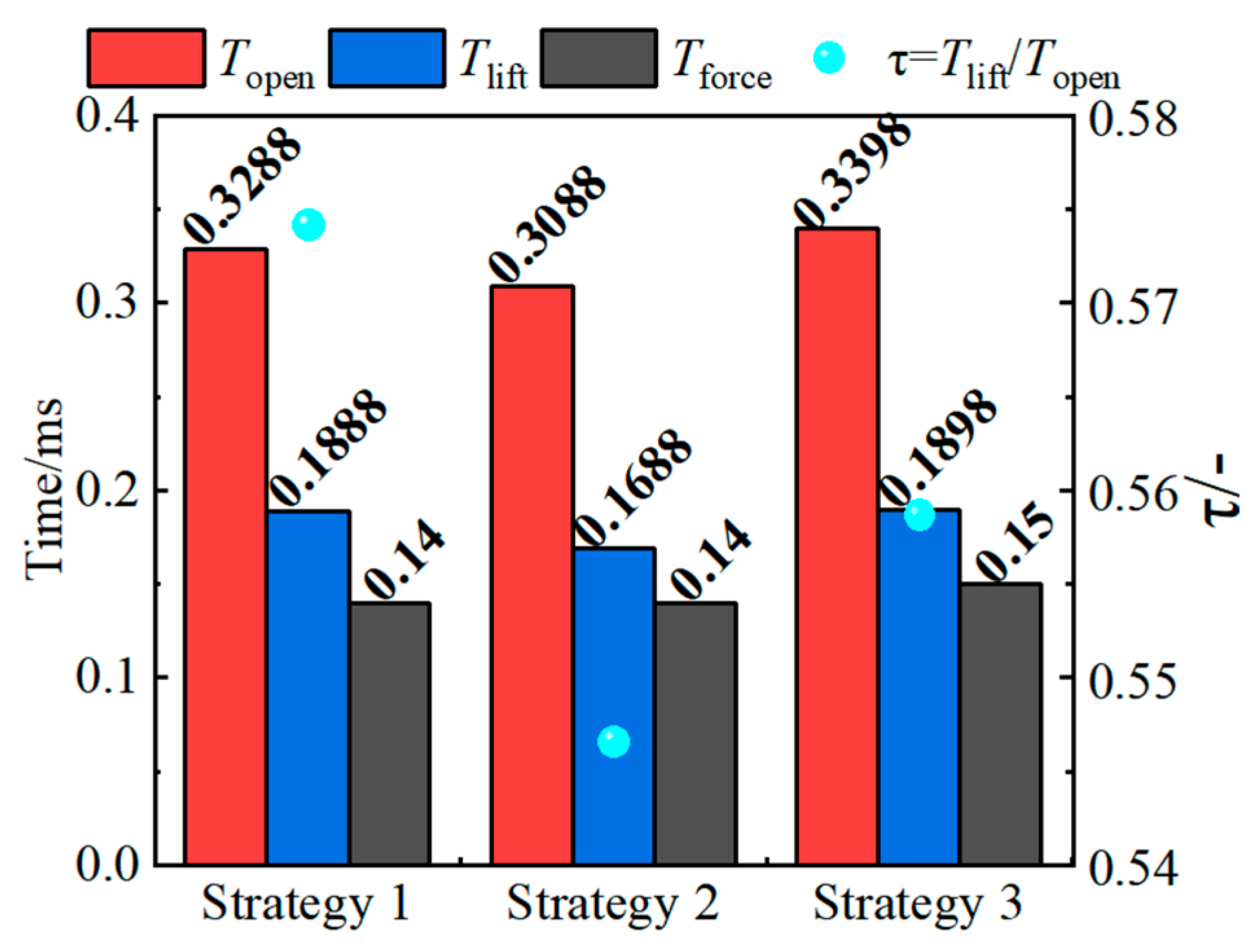
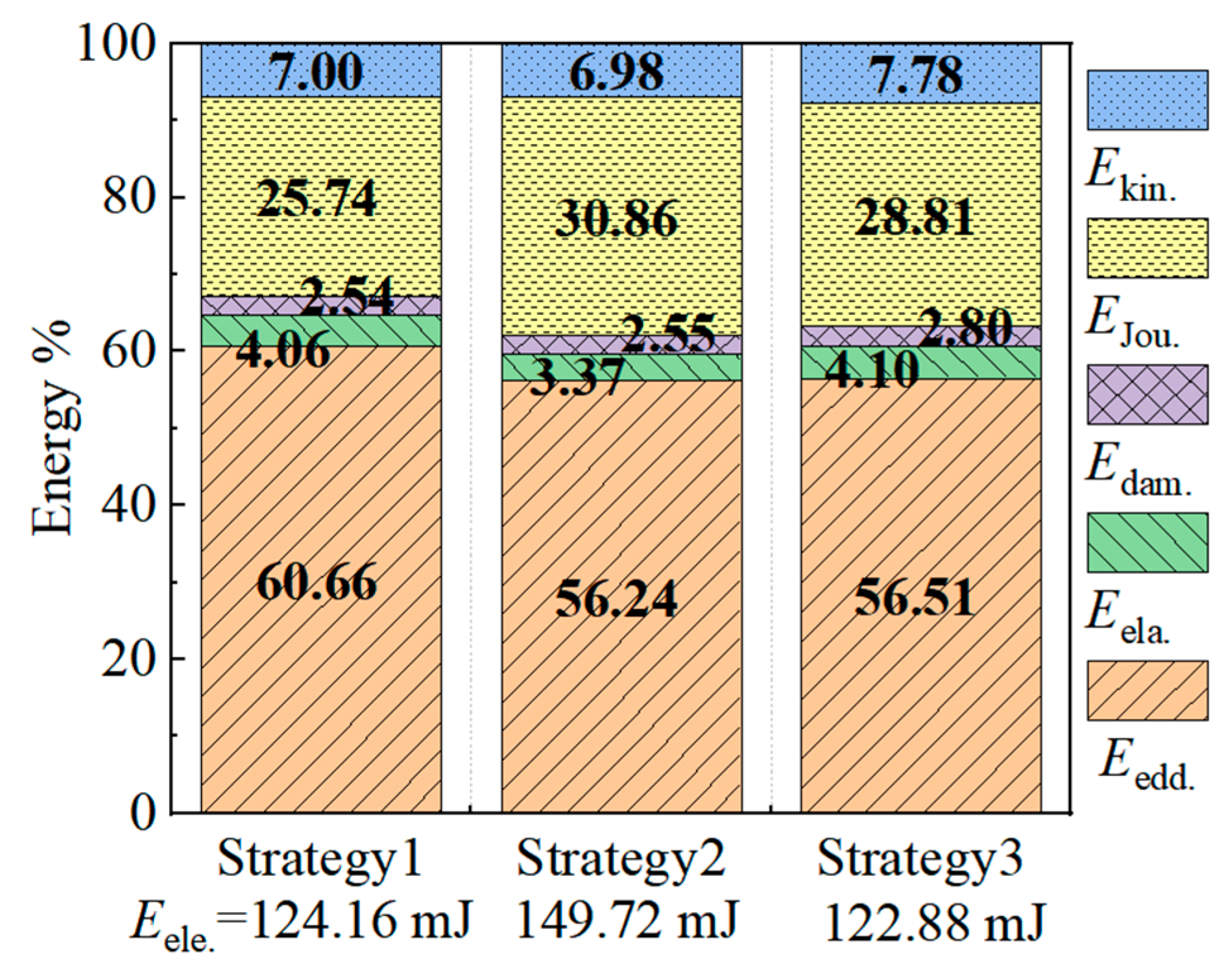


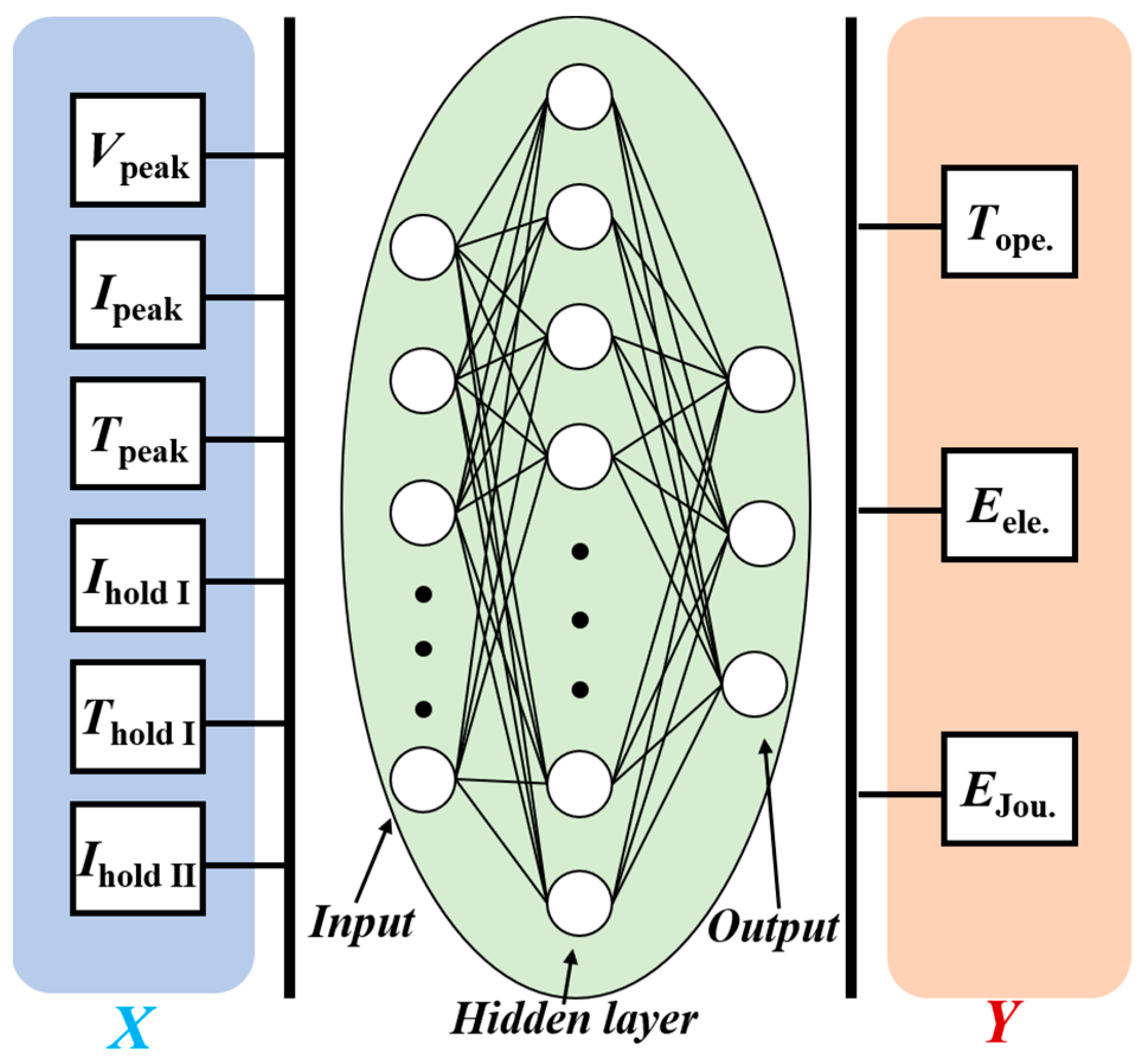
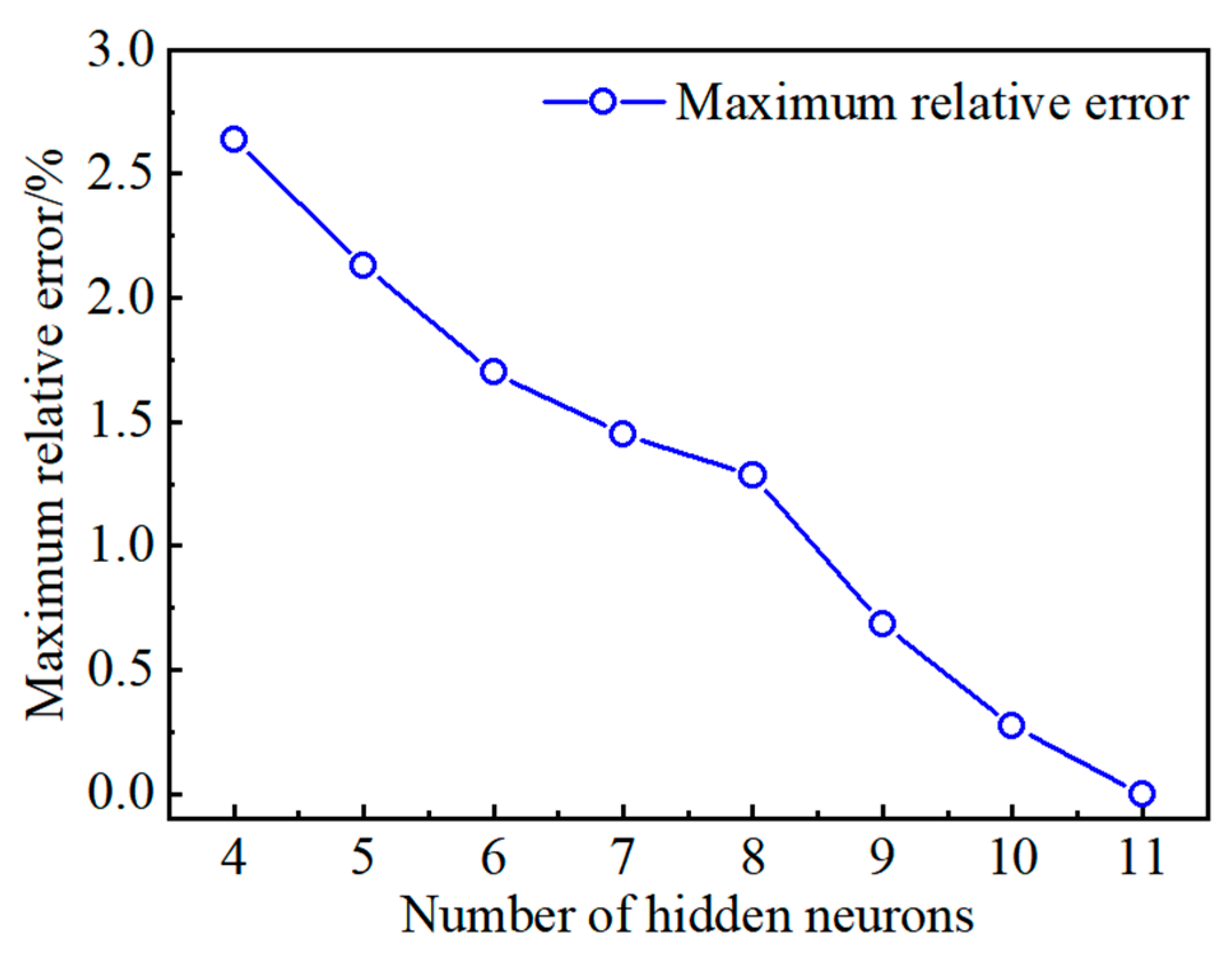

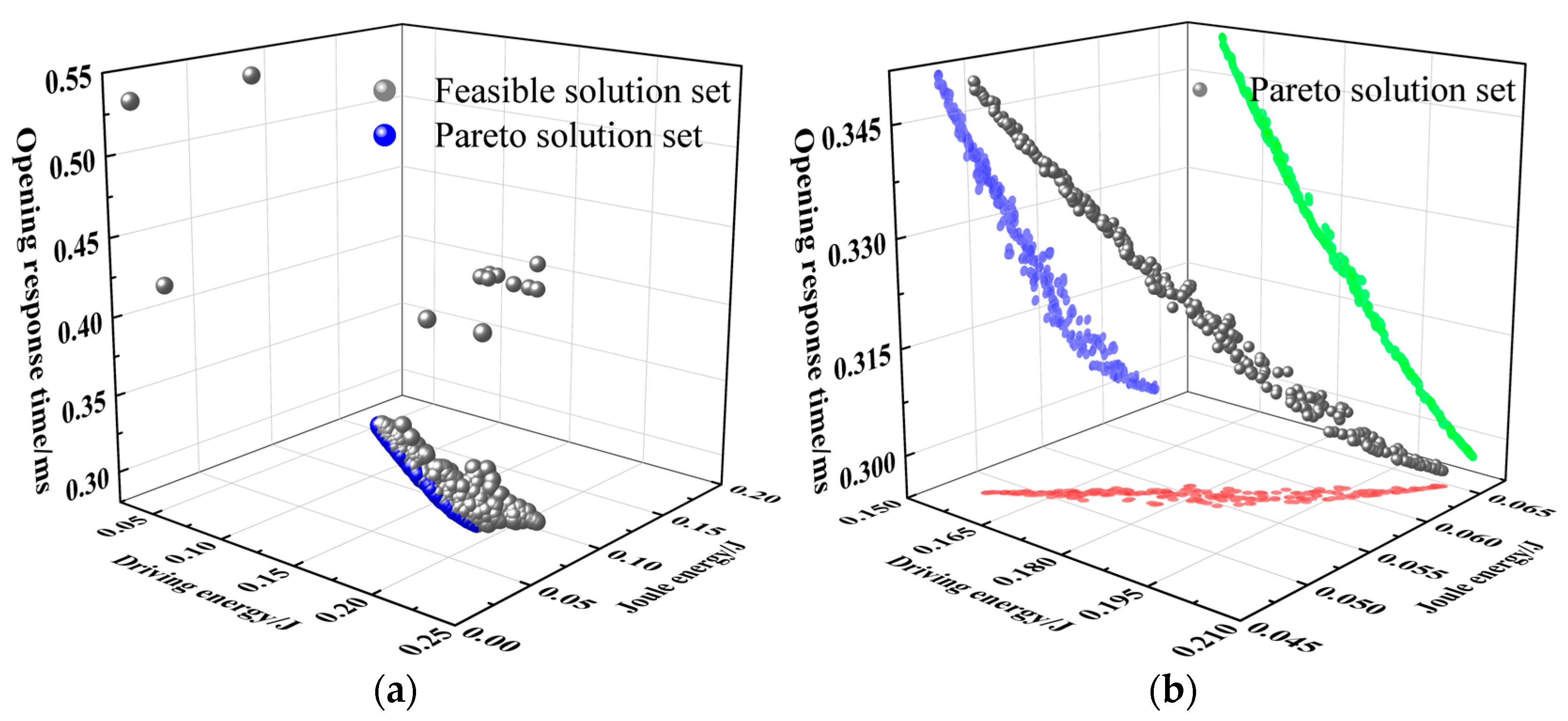
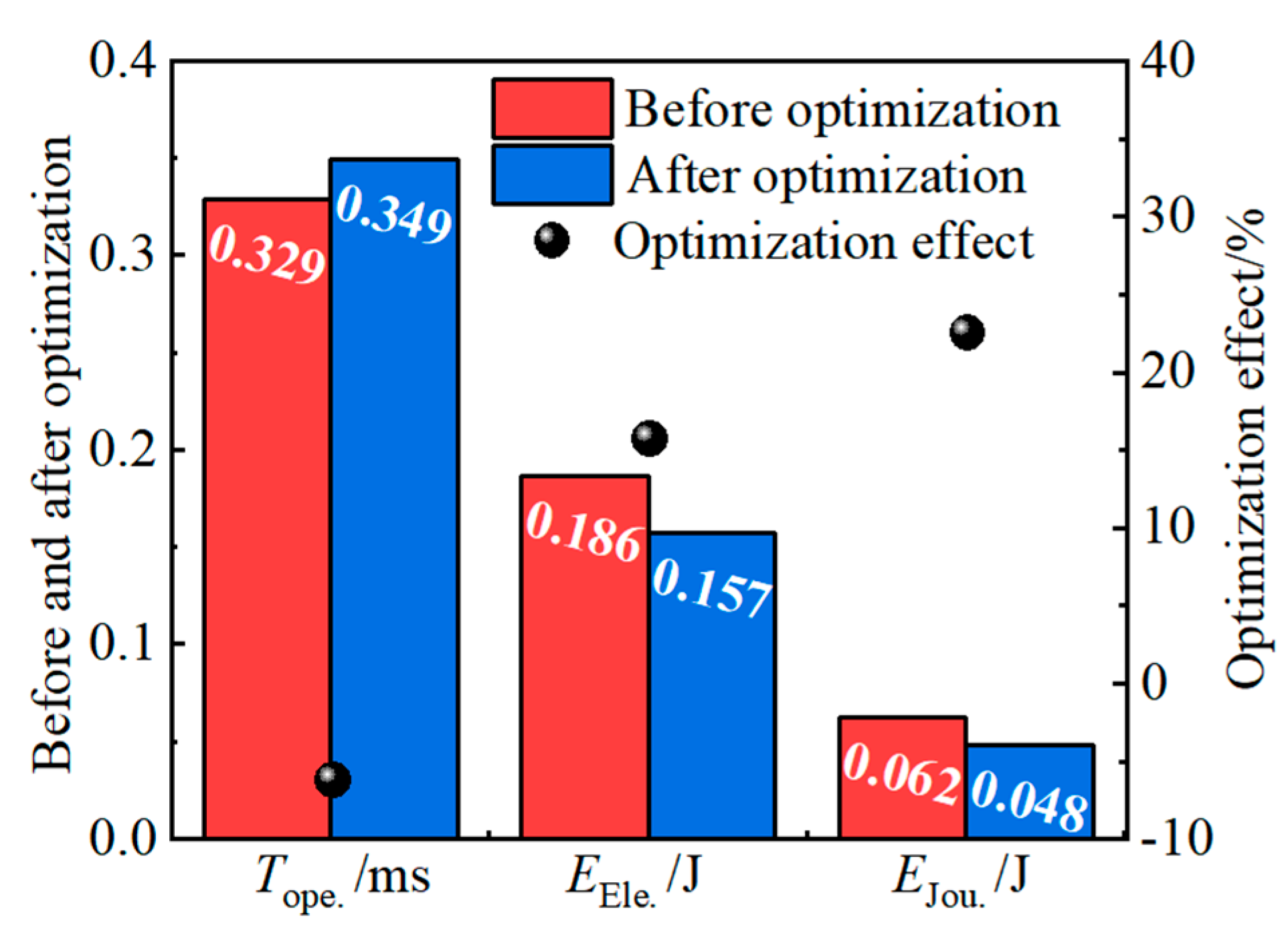
| Design Variable, Symbol | Unit | Strategy 1 | Strategy 2 | Strategy 3 |
|---|---|---|---|---|
| Peak voltage, Vpeak | V | 70 | 70 | 70 |
| Peak current, Ipeak | A | 24.5 | 24.5 | 19 |
| Peak current loading time, Tpeak | s | 0.00023 | 0.00049 | 0.00049 |
| First-order holding current, Ihold I | A | 14 | - | - |
| First-order holding current loading time, Thold I | s | 0.00049 | - | - |
| Second-order holding current, Ihold II | A | 5 | 5 | 5 |
| Design Variable | Level | ||||
|---|---|---|---|---|---|
| Lower | Standard | Upper | |||
| Vpeak/V | 65 | 67.5 | 70 | 72.5 | 75 |
| Ipeak/A | 23 | 23.75 | 24.5 | 25.25 | 26 |
| Tpeak/s | 0.00021 | 0.00022 | 0.00023 | 0.00024 | 0.00025 |
| Ihold I/A | 12 | 13 | 14 | 15 | 16 |
| Thold I/s | 0.00045 | 0.00047 | 0.00049 | 0.00051 | 0.00053 |
| Ihold II/A | 4 | 4.5 | 5 | 5.5 | 6 |
| Design Variable | Before Optimization | After Optimization |
|---|---|---|
| Vpeak/V | 70 | 65 |
| Ipeak/A | 24.5 | 23.0 |
| Tpeak/s | 0.00023 | 0.00021 |
| Ihold I/A | 14 | 12 |
| Thold I/s | 0.00049 | 0.000457 |
| Ihold II/A | 5 | 4 |
Disclaimer/Publisher’s Note: The statements, opinions and data contained in all publications are solely those of the individual author(s) and contributor(s) and not of MDPI and/or the editor(s). MDPI and/or the editor(s) disclaim responsibility for any injury to people or property resulting from any ideas, methods, instructions or products referred to in the content. |
© 2024 by the authors. Licensee MDPI, Basel, Switzerland. This article is an open access article distributed under the terms and conditions of the Creative Commons Attribution (CC BY) license (https://creativecommons.org/licenses/by/4.0/).
Share and Cite
Yu, Z.; Yang, L.; Zhao, J.; Grekhov, L. Research on Multi-Objective Optimization of High-Speed Solenoid Valve Drive Strategies under the Synergistic Effect of Dynamic Response and Energy Loss. Energies 2024, 17, 300. https://doi.org/10.3390/en17020300
Yu Z, Yang L, Zhao J, Grekhov L. Research on Multi-Objective Optimization of High-Speed Solenoid Valve Drive Strategies under the Synergistic Effect of Dynamic Response and Energy Loss. Energies. 2024; 17(2):300. https://doi.org/10.3390/en17020300
Chicago/Turabian StyleYu, Zhiqing, Li Yang, Jianhui Zhao, and Leonid Grekhov. 2024. "Research on Multi-Objective Optimization of High-Speed Solenoid Valve Drive Strategies under the Synergistic Effect of Dynamic Response and Energy Loss" Energies 17, no. 2: 300. https://doi.org/10.3390/en17020300






